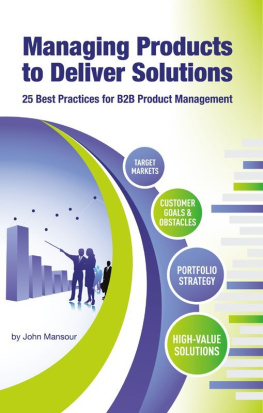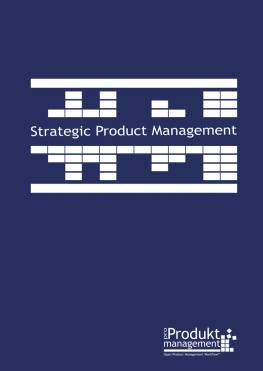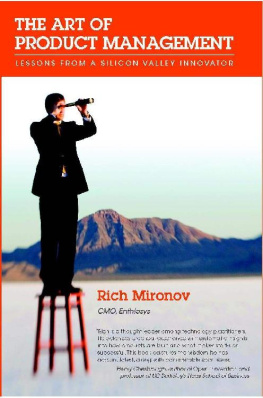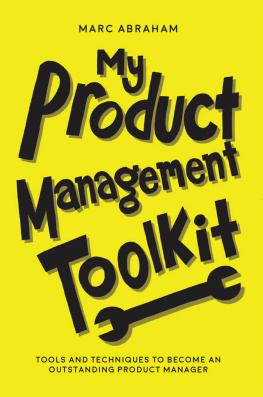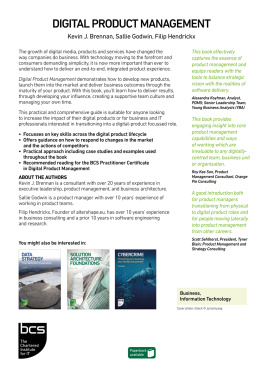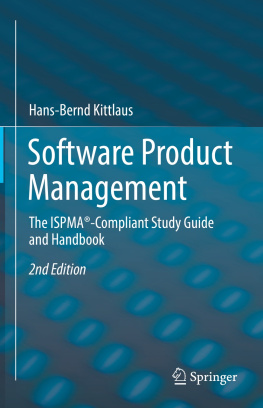
ISBN: 9781631927287
Table of Contents
SECTION I:
A WIDER LENS IS REQUIRED TO UNCOVER THE NEEDS OF A BUSINESS
1. Create a Customer-Focused Mission to Drive Product Management
A customer-focused mission drives the most successful product management teams. Its not the same as a company mission statement that articulates your companys values. What we are talking about in this context is a product management mission it reflects a goal that is critical to the success of every customer, and its stated in their words. It transcends time, markets, technology and products.
Why is mission so important? With countless issues, initiatives, new product ideas and your own business dynamics constantly pulling products in all directions, there has to be a common thread that keeps product management focused on addressing the needs most critical to your customer organizations. Ultimately, that thread has to be something meaningful to your customers something that resonates with everyone, from the top of their organization all the way down to the people doing the work in the trenches.
Some real-world examples:
- The product management mission of a seating solutions provider is to create more revenue-generating uses for the same audience space.
- The product management mission of a point-of-sale solutions provider for car washes is to wash more cars at a higher average transaction price per car.
- The product management mission of a data protection solutions provider is to minimize business disruptions by making sure data is always available when and where its needed.
A customer-focused mission is invaluable to product management because
- It serves as the ultimate yes/no qualifier for all product ideas. If an idea doesnt directly support the mission, its not valuable to the customer and subsequently not valuable to your organization.
- It forces product managers to see their customers the same way they see themselves and encourages collaboration across product teams to identify bigger obstacles and deliver higher-value solutions.
- Its a constant reminder that the customers goals are most important.
At the end of the day, product management has to be the conscience of the organization a voice of reason that keeps marketing, sales, engineering, finance and all other disciplines focused on three things:
- The goals of your customer organizations.
- Their biggest obstacles from the top all the way down to the trenches.
- The solutions your organization can and does provide, their value to the market, and their value to your organization.
In B2B, a customer-focused mission is the lynchpin to a strong product management discipline. That mission becomes the bulls-eye a constant reminder of what your customers are ultimately trying to accomplish. With a stronger focus on solutions (versus products), keeping that mission front and center ensures product management stays constantly focused on the most important thing: uncovering the biggest obstacles facing your customers, and delivering high-value solutions.
2. Uncover Top-Down Market Needs Instead of Solving Bottom-Up Market Problems
On the surface, the difference between solving market problems and uncovering market needs might seem like nothing more than semantics. But the implementation of each practice in B2B organizations reveals a huge contrast between the two with a ripple effect that can have a significant impact on the top and bottom line. One starts and ends with your users; the other starts at the top of the customer organization and ends with the people doing the work in the trenches eventually, your users.
Solving Market Problems A Bottom Up, Product-Centric Approach
Solving market problems is a product-centric approach that begins and ends with users of your products. The real world implementation of this practice amounts to three basic steps:
- Create personas of the target users (i.e., customer service reps).
- Identify problems those users have (i.e., it takes too long to find customer account information).
- Add new capabilities to each product to solve the user problems (i.e., expand the search criteria).
Meeting Market Needs A Top-Down Solutions-Centric Approach
Meeting market needs requires a much wider lens to identify needs that are more critical to the success of the customer organization. It requires product management to understand the business of its customers from the top-down an approach that ends with users versus starting with them.
It also requires greater collaboration across product teams to ensure a single view of the market; otherwise, each team is reading the market through their own product lens. Your end game should be to uncover needs most critical to the success of your customer organizations and then determine the products in your portfolio most relevant to creating the highest-value solutions.
Start with a clear definition of your target market segments. Call them what they call themselves (i.e., telecommunications providers) and then answer four questions:
- What are my customers trying to accomplish strategically and operationally? (i.e., improve customer retention and grow wallet share).
- Why are those goals important? (i.e., the market is saturated and theres little room for new growth).
- What are their biggest obstacles to meeting those goals? (i.e., customers defect to competitors for short-term price deals and its costly to win them back and make them profitable).
- Which products in our portfolio create the most compelling business solution?
Why is the Top-Down, Solution-Centric Approach Best For B2B?
Heres the thing: The product-centric approach encourages silos that constantly compete for resources to make each product successful. The typical end result? Each product gets a fraction of resources but no product gets enough to make a significant impact on the organizations top or bottom line. Marketing and sales are eventually forced into feature wars because theres no discernible difference in the size and scope of problems each product solves relative to the competition.
The solution-centric approach fosters greater collaboration across product teams with the goal of removing the most significant obstacles facing your customer organizations from the top down. Resources are weighted on products most relevant to creating the highest value solutions. Marketing and sales have stronger value propositions because your solutions go far beyond user problems and address needs that are more critical to the goals of decision makers the buyers.
How many organizations have the resources to make every product successful? Few, if any. In B2B, youll have much greater success as an organization when you put the emphasis on delivering high-value solutions that meet market needs rather than focusing on the success of individual products.
3. Three Guiding Principles to Innovation
Theres no question that innovation is one of the unique aspects of B2B product management. But a word of caution: Dont fall into a trap where innovation is synonymous with shiny new objects. Innovation should be a result, not a goal.
Unlike B2C, where innovation is about the next fad product, innovation in B2B is about solving age-old problems in unique ways no one has ever thought of, or solving problems the market never knew it had until there was a solution.
Stick to these three principles and youll uncover more valuable needs than you ever imagined.
Next page
